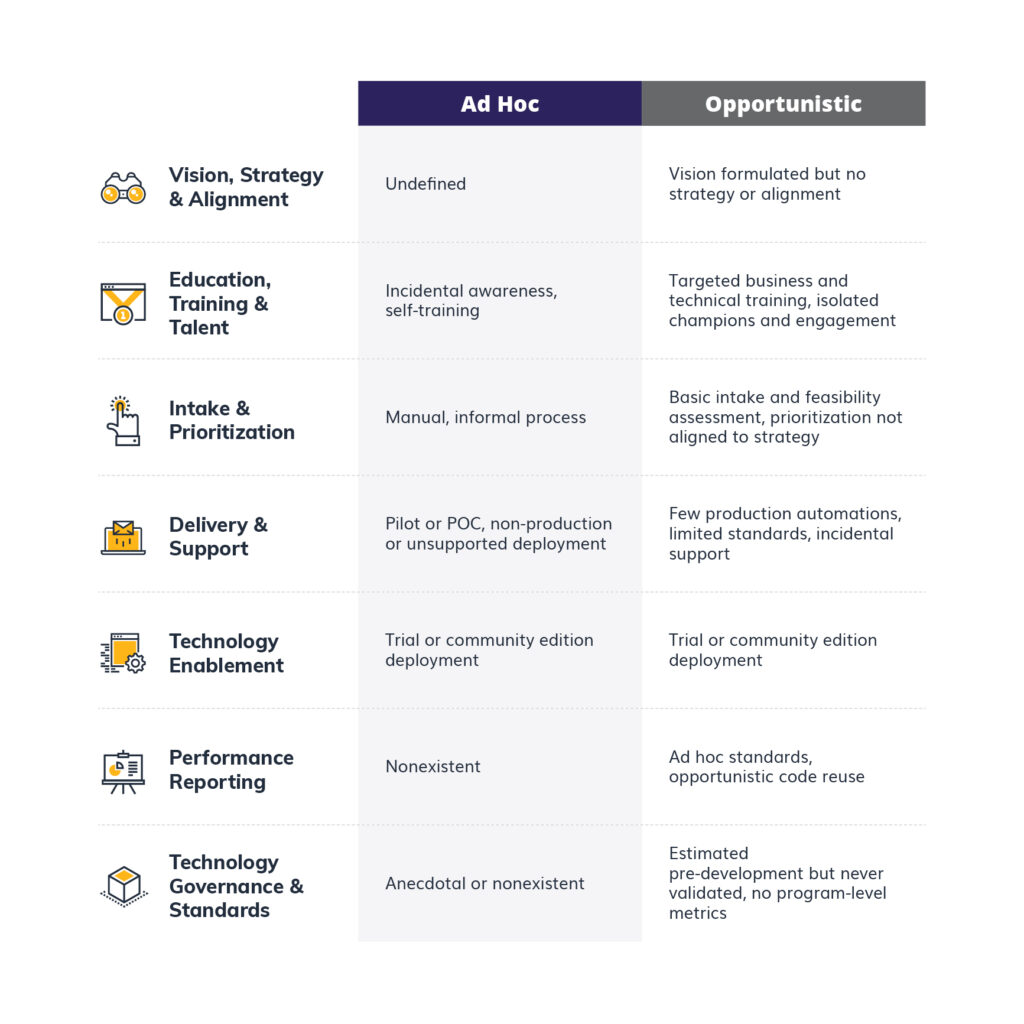In part two of our enterprise automation blog series, we discuss the second phase of your automation maturity journey, opportunistic maturity.
As automation becomes more popular, many organizations find themselves hesitantly dipping their toes in the water. They’re able to get a small project off the ground, but it barely moves the needle for the business. If they have tools that automate small processes, these do not align or work as a cohesive unit.
In this blog series, we’re highlighting how you can move further along the enterprise automation maturity model to scale and optimize across your organization. Like how you can be smarter about the tools you use for lawn care and how you apply them, the maturity model offers you tools and approaches to be smarter about your organization’s automation goals.
The journey to optimized enterprise automation doesn’t happen overnight.
We use a maturity model that evaluates across four primary areas: organization, operation, enablement and reporting. Each area includes subcategories that will help you paint the bigger picture. Organization covers the structure and vision of the program and how you should train and manage team members. Operations is about how the automation program enhances your business through intake and support. Enablement keeps the lights on while maintaining a strong foundation. Reporting helps you understand the performance of automations.
So, where is your organization in our maturity model? If the scenario above sounds familiar, you’re in the first stage – ad-hoc maturity. Below, we’ll explain how you can graduate to the second stage – opportunistic maturity.
Organization
Vision, Strategy and Alignment
Forming your vision starts you down the path to enterprise automation maturity. Your vision will become your North Star, guiding and directing you in how you think about automation.
That said, not every vision needs to be about reaching the stars. If your needs are small, your goals can be small, too. Instead of training teams of citizen developers, for example, you may benefit more from a small team of experts dispersed throughout your organization’s structures. For example, your vision could be: “To improve customer and employee satisfaction by removing manual tasks and speeding up cycle times.”
When building your vision, think about the next three to five years. Ask yourself these questions with a long-term mindset:
- How will your teams do their work?
- What silos could be more self-sufficient?
- What mergers, acquisitions or major organizational changes could impact automation efforts?
- What major systems does your organization use?
- How do you move data in and out of each system?
Use the answers to these questions to identify gaps between your current and future state. These gaps can drive your vision for automation in the future. Be sure to keep in mind your organization’s capability for automation. Just like identifying the ideal mower for your yard, you don’t want to over or undersize your goals. Having a 54-inch deck on a zero-turn lawn mower doesn’t make sense if your yard is the size of a pickup truck. Alternatively, a reel manual push mower isn’t ideal for a multi-acre estate. Make sure you identify the vision that appropriately matches your organization.
Enterprise Automation Education and Talent Training
Many organizations often overlook training or only allocate it for technical resources, but it’s a key part of your automation journey.
To scale toward opportunistic maturity, train a select group of champions on power-user functionality or take them through specific business analytics training related to your automation tools. You could have champions within multiple departments or on multiple teams who will work with automations.
For example, UiPath breaks down its training by role, including automation users, testers, developers, analysts, IT, architects and more. Most mature automation providers have a similar level of training differentiation.
Operational
Enterprise Automation Intake and Prioritization
When beginning to intake and prioritize your automation processes, a center of excellence (COE) – an internal team dedicated to overseeing enterprise automation initiatives – provides governance and standards. As we continue through this series, we won’t dive deeply into how you can build and manage a COE, but we will build on the concept.
At this stage along the maturity model, aim for simple feasibility and prioritization. You can accomplish this setup by simply using Excel spreadsheets to identify your return on investment. Many tools help keep prioritization in order, such as ROI calculations, organizational impact, development complexity or a priority matrix.
Once you categorize automation opportunities and the ROI associated with each, it’s time to talk with leadership to help decide the appropriate next step. Targeting the project with the biggest ROI isn’t necessarily the right answer.
Automation Delivery and Support
Moving your delivery and support to an opportunistic stage is less about making changes and more about learning your organization’s Software Development Lifecycle (SDLC) by deploying automation in production.
Start with smaller automations for a minimal-risk way to familiarize your team with the new way of working. Use this as an opportunity to illuminate the implications of automating certain elements of the process and how it may affect the team’s dynamic.
Taking those first steps will give your team something to react to, build on and develop into standards or documentation they can use moving forward.
Enablement
Enterprise Automation Technology
The automation technologies used at the maturity model’s initial stages are still starter or community editions. If your vendors have sold you on enterprise licensing, take a hard look at when you can actually take advantage of those existing licenses before your renewal dates.
Look across your technology landscape to see where you have existing technologies for enterprise automation or if your vendors already have automation platforms. For example, some enterprise resource planning (ERP) providers also have robotic process automation (RPA) or even business process management (BPM) systems that can integrate within your existing ecosystem.
You also want to determine whether a certain combination of providers or systems makes sense for your organization. If you avoid poorly integrating platforms, it will make your life easier when building and executing automations. Not being able to interact with other platforms or tools will cause further complications in your journey toward enterprise automation maturity.
Governance and Standards
Across automations, you may have areas you can build for reuse in a component library. Highlighting these areas and moving them higher in priority can help move your organization to a well-managed automation program.
For example, can you use naming standards for different components? What areas need identical naming standards? What areas do you need to name differently?
Creating and sharing a log of all the naming standards will enable the delivery and support team to update any existing automations to those standards.
Reporting
The goal of reporting at the opportunistic stage is to ensure the feasibility of potential automations. Success rate or automation rate and throughput are the two main measures you should track at this stage. This step doesn’t need to be complicated: a simple weekly or monthly status report stating that you automated X% of all transactions this period and that you increased your throughput by X% percentage is sufficient at this stage.
Conclusion
The effort needed to move to an opportunistic stage is fairly minimal but sets the groundwork for how your organization approaches automation moving forward. Starting with a comprehensive vision for your dream lawn is necessary before embarking on a major lawn do-over.
The same goes for business transformation. Incorporating more advanced tools, like an automated sprinkler system – or a new RPA vendor – comes after the basic tools are accounted for and the groundwork is set. Next, we’ll look at how an automation COE provides maturity and governance on your journey to building an operationalized automation program.


